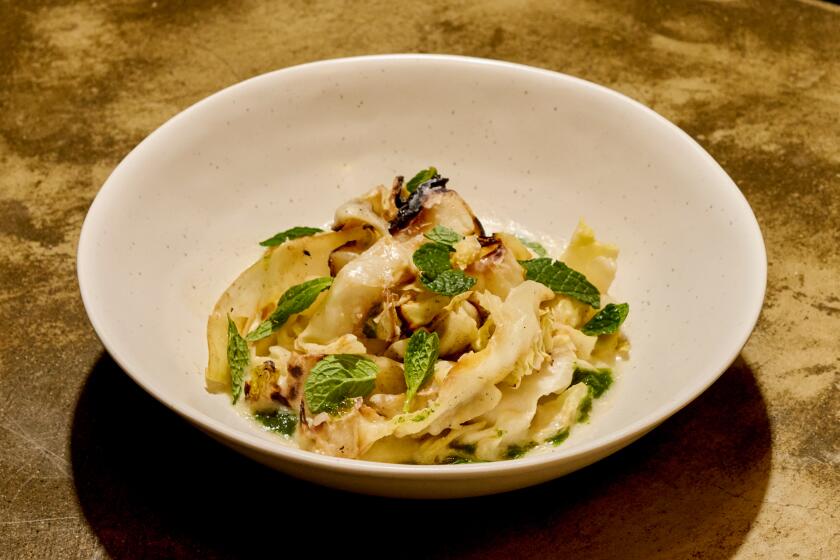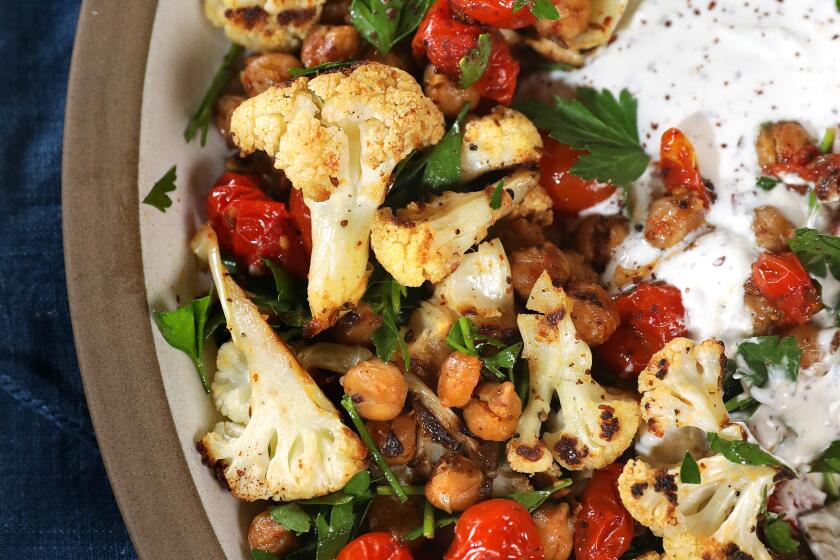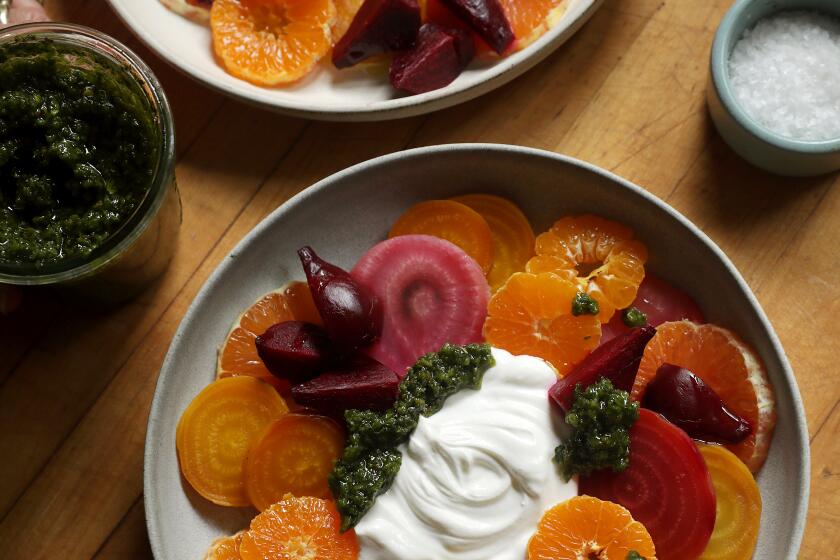Pork Schnitzel With Arugula Salad

Nobody fries anymore--not at home, anyway. That’s the conventional wisdom. But when you think about it, you’re frying every time you cook something in hot fat--whether it’s a big pot full or just enough to wet the bottom of a skillet.
All that changes is the amount. The final goal and the basics of how frying works are the same. It’s been compared to the difference between the rites of certain Baptist sects: a damp forehead versus full immersion.
This similarity is of more than ecclesiastical interest. Many of the problems people run into when sauteing arise because they don’t make that connection. Does your chicken stick to the pan? Does your fish come out pale and pasty? Do you have a hard time getting a good, flavorful crust on food? The answers lie not in your stars but in your skillet.
When you fry something, first be sure you have enough oil to do the job--there should be as much as 1/4 inch of oil in the skillet. And make sure the oil is hot enough. Both principles apply whether you’re deep-frying or sauteing.
In both cases, oil is what cooks the food--the pan is merely there to hold it and heat it. Use too little oil when you’re sauteing and all of the food won’t come in contact with it. You’ll find pale patches instead of that delicious even browning you get with good frying.
At the same time, if the oil isn’t hot enough before you add the food, you’re in trouble. The food will cook through before the surface begins to brown. Instead of a crisp crust, you’ll have a pasty surface.
Health alarmists may rail at using this much oil to cook, but tell them to go away. If the oil is hot enough, the food won’t absorb nearly as much as if you’d skimped on oil and cooked too early. And because you pour off everything left over, what’s the harm?
We could cure most of the world’s frying problems overnight if cooks would remember to do one simple thing: Before adding food to a pan, dip a little corner of it in the oil. If the oil isn’t hot enough to immediately sputter, just wait until it is.
Once the fat is under control, it’s time to turn to what will clothe your food. This coating does two things: It protects delicate foods from the intense heat of the oil, and it makes sure the surface is completely dry, to keep it from steaming when it cooks.
Some foods, of course, can be fried nude. Steaks are tough that way, and chicken’s got its own fatty skin for protection. Most times, though, you’ll want to roll the food around in a little something before frying.
There are three kinds of coatings. At one extreme is a simple dusting of flour or a roll in bread crumbs. You’ll notice when you do this that not much will stick. The crust will be thin and fragile. At the other extreme is a batter--a thick combination of starch and liquid, usually with flavorings and a leavening added.
There is a third way that is somewhere in between. It gives you a thicker, crustier crust simply by adding a kind of glue that helps the bread crumbs stick to the food. First dust the food with flour to remove any surface moisture. Then roll it in an egg wash--eggs beaten with a little water. Then dredge it in bread crumbs.
This is a messy procedure, but the result is delicious. I find the easiest way to do it is to have everything lined up in a row, assembly line-fashion: flour in a dinner plate, egg wash in a broad pasta bowl and a big pile of bread crumbs in a mixing bowl. Work on one piece at a time, passing it from one bowl to the next.
Don’t go overboard on the coating. Shake the piece of food after dredging in flour and after egging to remove any excess. Bury it in the bread crumbs and press firmly to make sure the coating sticks thickly and evenly. Then gently shake off any extra.
Professionals get very adept at this. You’ll see chefs using their left hands for dry ingredients and their right for wet. They put the meat in the flour, then transfer it to the egg wash with one hand. Then they switch to the other for moving from the egg wash to the bread crumbs. Then they revert to the first hand to remove it from the bread crumbs. This keeps them from getting both hands all gummed up when they’re frying a few hundred pieces. Whether you want to go to the trouble is up to you.
Fry the food quickly in very hot oil and don’t try to do too many pieces at a time. Especially when you’re working with only a little fat, overcrowding the pan will cause the temperature to drop too far.
When the food is done, remove it to a plate lined with a paper towel and gently pat it on all sides to remove any excess fat. Season it and then serve it immediately.
Fried food, like salvation, doesn’t wait.
Rinse pork but do not pat dry. Place 1 piece pork in a heavy duty resealable plastic bag and pound with rolling pin until about 1/4-inch thick. If using pork chop, be careful not to pound bone. Remove pork from bag and season with salt on both sides. Repeat with rest of pork.
Place flour in wide mound on dinner plate. Beat egg with water until smooth. Combine bread crumbs and cheese in large mixing bowl. Place arugula in salad bowl and dress with oil and lemon juice and season with salt.
Heat oil in large skillet over high heat. Roll 1 piece of pork with flour and shake off excess. Dip in egg bath and shake off excess. Place in bread crumbs and cover well. Press to firm coating, then remove and gently shake off excess. Repeat with remaining pork pieces.
Dip 1 corner of cutlet in oil. If oil is hot enough, pork will sizzle loudly. If this happens, add pork to pan and repeat with remaining pieces. If oil is too cool, wait until it is hot enough. Fry cutlets until well-browned on bottom, 2 to 3 minutes. Turn over, salt cooked side, and cook 1 to 2 minutes longer. Remove to paper towel to drain and salt second side. Repeat with remaining cutlets.
Place each cutlet on plate with best-browned side up, then place handful of dressed arugula on top. Serve immediately.
Get our Cooking newsletter.
Your roundup of inspiring recipes and kitchen tricks.
You may occasionally receive promotional content from the Los Angeles Times.














